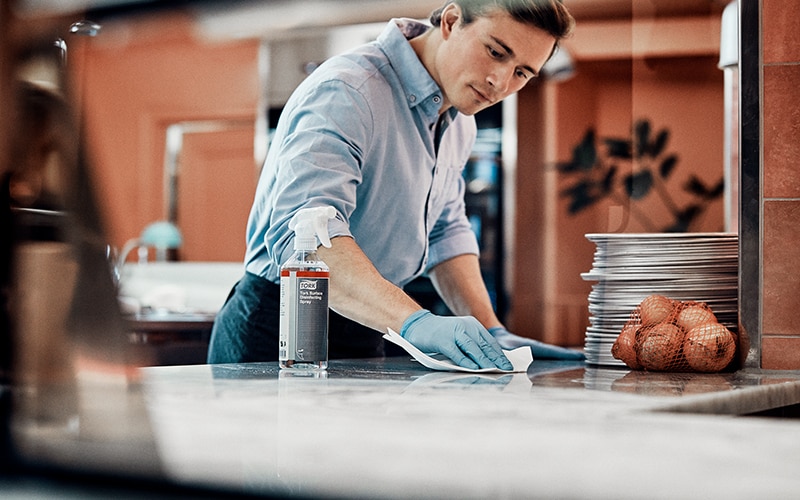
What is the difference between cleaning, sanitizing, and disinfecting?
Picture this: a busy restaurant, a long waitlist, and a newly vacant table that needs to be cleared and cleaned for the next guest. The waiting staff are probably rushing to clear the table and turn it around — cleaning and sanitizing the surface as fast as possible. However, are they doing it correctly and efficiently? Maybe, but during a mealtime rush, it can be incredibly difficult to maintain a high level of cleanliness. One of the best ways to optimize this process is through the adoption of the right hygiene routine, consisting of three key functions: cleaning, sanitizing, and disinfecting. You might think these functions are one and the same, but they all have different applications that need to be applied in a full regimen to create a safe, hygienic workplace.
The food service industry is only one example of where your colleagues need to be aware of the distinction between these functions. Each industry will have different hygiene risks and requirements, and finding the right division of time between the three functions is the key to creating a work environment with a high cleanliness level.
So, let’s unpack the difference between cleaning, sanitizing and disinfecting:
What is cleaning?
Cleaning is an important first step to make sure you remove any dirt, debris and harmful bacteria and viruses from any surface. Using a wiper or cloth as well as cleaners that contain soap or detergent will remove germs and dirt on surfaces and reduce the risk of infection. Cleaning alone removes most harmful viruses or bacteria from surfaces. Surfaces should be cleaned before they are sanitized or disinfected because impurities like dirt may make it harder for chemicals to get to and kill germs.*
Is cleaning enough by itself?
Cleaning is great at removing some short-term hygiene hazards – like contaminants such as food crumbs and loose hairs - but in the long run, it’s essential to carry out a full regimen of cleaning, sanitizing, and possibly even disinfecting.
When is cleaning the best option?
Cleaning is great at removing some short-term hygiene hazards – like contaminants such as food crumbs and loose hairs - but in the long run, it’s essential to carry out a full regimen of cleaning, sanitizing, and possibly even disinfecting.
More hygiene hazards cleaning can help you remove:
Allergens
Even small amounts of allergens such as insects or peanut shells can be very dangerous for your colleagues and customers, so removing them from surfaces as quickly as possible is vital.
Visible dirt
As well as spreading potentially harmful bacteria, visible dirt gives your workplace an unhygienic appearance.
Untidy work areas
Our work areas see a lot of different hazards. The average desk is likely to have daily encounters with food, hands, and contaminants.
This principle can be applied across many different industries, and as a rule, routine cleaning can be extremely effective in reducing contaminants on surfaces, particularly when paired with regular sanitizing.
What is sanitizing?
Compared to cleaning, sanitizing focuses on killing harmful bacteria found on surfaces. This includes removing microbes. The word “sanitize” means you are killing specific types of bacteria in a specified amount of time, lowering them to a level deemed safe by public health standards. In the U.S., Environmental Protection Agency (EPA) certification is required any time a manufacturer makes this claim. End users and customers will need to make sure the sanitizing product they’re purchasing is registered with the EPA.
What is disinfecting?
While sanitizing involves killing bacteria, disinfectants are considerably stronger, killing bacteria and viruses. The EPA refers to disinfectant as a solution that ‘inactivates 99.999% of germs’** on a surface when given enough dwell time.
This task is more closely associated with healthcare settings, as opposed to food service environments, but it can still be applicable in areas found across all industries, like washrooms.
What’s the difference between sanitizing and disinfecting?
The key difference between disinfecting and sanitizing is the type of chemical involved and how long it’s left on a surface. For many disinfectants, 10 minutes is the appropriate dwell time. But, to ensure proper disinfection and safety, be sure to read the instructions on the chemical product.
To keep a hygienic and safe business, it’s important to complete the full regimen, starting with cleaning, then moving on to sanitizing and disinfecting, when appropriate. Most importantly —always read the instructions found on the label when dealing with products, particularly when using them in combination with other cleaning supplies.
Boost the efficiency of your workplace with proper cleaning
Whether you're upgrading your wash stations or taking steps to improve hand hygiene, having the right types of products can make a huge difference in increasing efficiency. See how Tork can support your business in creating efficient and clean environments to work in.
Consider upgrading to data-driven cleaning
Tork Vision Cleaning utilizes data-driven cleaning to help you improve your cleaning quality and support better hygiene in your workplace, while also increasing efficiency. Find out more and book a call to see how Tork can help your cleaning processes.
